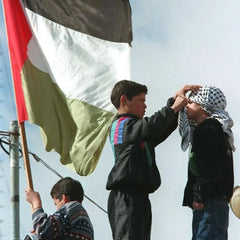FAQs
What are the estimated shipping times?
Currently, the estimated delivery time is approximately 3 to 5 business days. Our stock is shipped from Palestine to our fulfilment centre in US, and then each order is dispatched individually.
Which payment methods do you accept?
You can pay through PayPal, credit card, debit card, or Sofort Banking. If you are located in the EU.
Can I change my order?
Changes to your order are possible only if it hasn’t been sent to the warehouse. If you haven’t received a shipping confirmation, please provide your order number, the product you ordered, and the one you wish to receive. We’ll do our best, but please note that most Kufiyas are already sold out.
Can I change my shipping address?
If your order hasn’t been dispatched, we can attempt to update your address. Please provide your order number and the new, complete address, including country and mobile number, in your request.
Received the wrong product?
We apologise for any mix-up. Our warehouse team works hard under pressure, and occasional errors can happen. Please email us (preferably by replying to your order confirmation) with a photo of the received items. We’ll address the issue promptly.
When is the next restock?
We restock every 2-3 weeks. Be sure to sign up for our email notification and follow our social media channels for updates.
What does wearing a keffiyeh mean?
The keffiyeh has become a marker of freedom and the human rights struggle of Palestinians. Originally popular amongst farmers as a form of sun protection, the traditional headscarf has come to symbolise sovereignty and solidarity with the Palestinian cause.
During the Ottoman period, the keffiyeh was worn by rural workers whilst the more urban classes boasted the red felt hat known as the tarboosh. However, during the Arab Revolt of the 1930s against the British colonial occupation of Palestine, Palestinians of all classes began wearing the black and white head covering in a show of national unity.
Gradually, the keffiyeh gained international attention, particularly after being seen around the shoulders of prominent Palestinian politician, Yasser Arafat. Especially during the three decades in which Israeli authorities banned the Palestinian flag (1967-1993), the keffiyeh gained popularity worldwide as an expression of Palestinian identity.
Today, wearing the keffiyeh is seen as an unspoken expression of solidarity with the Palestinian people, in their pursuit of freedom.
Is it cultural appropriation to wear a keffiyeh? Who is allowed to wear a keffiyeh?
The keffiyeh can be worn by anyone in support of the Palestinian cause. In fact, Palestinians love to see people from around the world expressing support through this meaningful fabric. When you choose to wear a Keffiyeh made in Palestine, it means you are aware of its cultural significance and are benefiting its original community. Whereas, wearing an imitation just for fashion, without any connection to its roots, can be considered cultural appropriation.
What religion wears the keffiyeh?
The keffiyeh is a non-religious form of clothing. It is popular amongst Christians, Muslims, Druze and even secular people across the Middle East. Rather than holding any religious symbolism, the keffiyeh is simply donned across the region as a form of traditional clothing.
Indeed, not all people in this region wear the keffiyeh, and even those that do might wear it differently to the Palestinian keffiyeh. For instance, whilst the Palestinian and Syrian keffiyeh is black and white, the Jordanian shemagh boasts red and white checks. Likewise, the plain white ghutra is popular among countries in the Gulf like the UAE, Qatar and Bahrain.
What country is the keffiyeh from?
The keffiyeh is most commonly associated with Palestinian culture. However, this headscarf originates as far back as 3100 BCE Mesopotamia, in the Kufa region of today’s Iraq. Since then, it gradually gained popularity across the Middle East.
Today, the keffiyeh is worn in Jordan, Syria and across the Gulf, albeit using different patterns and cloths. However, as the traditional black and white keffiyeh has become popular as an expression of Palestinian identity, it is globally recognised to be a product of Palestinian culture and history.
What material is the keffiyeh made from?
The kufiya is made of 85% organic cotton for a natural and breathable fabric, and 15% high quality synthetic thread that is used to help maintain the durability and shape of the kufiya.
What are the instructions for washing a kefiyeh?
We typically recommend hand washing a kufiya to accomodate the delicate fabric. You may also machine wash at a delicate setting. We advise using a mild detergent, and to air dry the kufiya after washing.
What weather conditions are suited for wearing a keffiyeh?
The kufiya is a versatile headdress suited for both cold and warm weather conditions. It may be used as a light scarf for warmth, and can alternatively keep you cool in hot climates under direct sunlight. The kufiya offers effective shielding against dust and fast-blowing winds, and excellent moisture-wicking properties, directing sweat and moisture away from the skin.
If you have any questions, feel free to contact us at palestinian.kufiya@gmx.com

